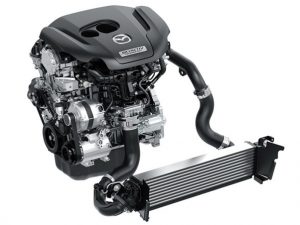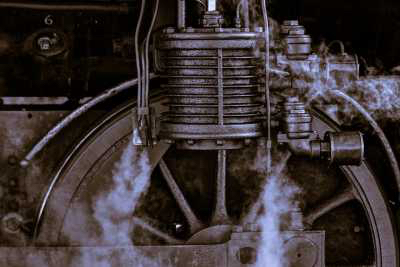How good do we have it?
If the measure of that is the power and performance delivered by the average new car, the answer has to be: Pretty damned good.
Four cylinder-powered family-haulers like the 2018 Mazda CX-9 I just reviewed haul more ass than the V8-powered muscle cars of my youth. Than the V8-powered muscle car I have in my garage. At least, when it was new.
But it’s a story with two sides.
The first side is the almost miraculous power and performance – and drivability, reliability, durability and mileage – achieved by the designers of today’s Mighty Mouse engines. Four cylinder engines routinely produce more horsepower – and torque – than V8s twice their size used to. Which has rendered V8s functionally unnecessary – even in large, heavy family-hauling vehicles like the CX-9.
V6s, for that matter.
The Mazda no longer offers one – because it doesn’t need one. The 2.5 liter four under the hood of this seven passenger, 4,000-plus pound family bus makes 250 hp and 310 ft.-lbs. of torque. This is sufficient not only to haul the CX-9 and its passengers, but to haul ass.
It gets to 60 in just over 7 seconds.
My muscle car – when it was new – came with a 7.4 liter (455 cubic inch) V8 engine, the biggest engine ever put into any muscle car. It was the most powerful engine you could buy that year (1976) and so-equipped, the Pontiac Trans-Am was the quickest muscle car you could buy that year. Quicker than the Corvette, even.
It was about as quick – with a close-ratio four-speed manual transmission – as the 2018 Mazda CX-9.
If you didn’t order AC – it was optional – and skipped weight-adders such as power windows and so on – a stock ’76 TA 455 4-speed might just edge out a 2018 CX-9 (with automatic transmission and climate control AC) in a straight-up drag race.
And now for the other side of the story . . .
The CX-9’s four makes tremendous power, but it is maxed out – or close to it. The little engine is pressurized to nearly 18 PSI via a turbocharger. Its cylinders literally force-fed air – in the manner of a pate de foi gras Goose – to make up for the lack of displacement. It is also like feeding a little guy steroids to make up for his small physique.
He bulks up.
But it’s not natural. There are costs.
Adding a turbo – and an intercooler – adds at least $1,500 to the cost of the engine. A V6 (or V8) that made equivalent power could be made much cheaper.
And would probably last longer.
There’s also not much more to mine,probably. The engineers have already resorted to pretty much every trick in the book – turbocharging, direct fuel injection; cylinder deactivation, variable cam timing – to make up for what the government has been working to systematically take away (i.e., power and performance) in the name of reducing emissions to nearly nil.
How will they cope with future government demands for effectively zero emissions and average fuel economy numbers in the mid-50s?
The Trans-Am’s V8 had tremendous latent power. It came from the factory grossly under-stressed. It made 200 hp – and 330 ft.-lbs. of torque – with one hand tied behind its back. Because of government edicts – at that time, mostly having to do with tailpipe emissions standards – Pontiac engineers had to de-tune the V8. They lowered the compression (to an almost unbelievable 7.6:1) and installed the mildest camshaft they could that would leave the engine capable of running at all.
But the essentials – the building blocks – were all still in place.
The latent power locked up in that huge V8 was just waiting to be summoned. You could literally double the horsepower it made with a cylinder head and camshaft swap, plus some tuning. The parts were not expensive – and the install was easy. Almost anyone so inclined could do it – and could afford to do it.
This was the way we got around Uncle in those days – and not just us.
The car manufacturers helped us end-run Uncle, by making sure we still had the essentials, by giving us all that latent potential. Some even went to the lengths of engineering hop-up parts that came with a label, “for off road use only” . . .
Today, there’s not much latent potential left – and what there is isn’t easily or inexpensively accessed. The car industry – having given up on the idea of fighting Uncle – embraces him.
. . .
Got a question about cars – or anything else? Click on the “ask Eric” link and send ’em in!
If you like what you’ve found here, please consider supporting EPautos.
We depend on you to keep the wheels turning!
Our donate button is here.
If you prefer not to use PayPal, our mailing address is:
EPautos
721 Hummingbird Lane SE
Copper Hill, VA 24079
PS: EPautos magnets – they’re back! are free to those who send in $20 or more to support the site. Also, the eBook – free! – is available. Click here. Just enter you email in the box on the top of the main page and we’ll email you a copy instantly!












My mechanic cuz sez go to six cylinders above 2.0L.
I can’t imagine the high-compression fours being too much cleaner anyway because you start producing NOxs at those temperatures. Mind you, I’ve been wrong before.
Hi J,
There are two things which concern me about small displacement, heavily turbocharged engines in daily driver cars. The first is that the pressurization of the engine will result in more rapid wear and tear and earlier failures and higher maintenance costs over the life of the vehicle. What condition will these engines be in after say 100,000 miles of regular use? This brings me to the second concern – the turbocharger itself. This is an expensive piece of hardware. If it needs to be replaced – and that need occurs after 100,000 miles, when the value of the vehicle is about a third of what it was when it was new – the cost to replace the turbo may prove to be economically catastrophic. Spending $2,000 to replace a turbo on a car worth $5,000 is a tough call to make.
Meanwhile, a V6 without a turbo will usually go 200,000-plus miles without major repairs needed and what repairs it does require are generally affordable relative to the value of the car as it ages.
We haven’t even come close to getting more power from small displacement. When they start going down the sleeve-valve with power recovery shafts hooked up to turbo-charger, you’ll know we’re in trouble. Here is the ultimate evil diesel.
https://en.wikipedia.org/wiki/Napier_Nomad
Hi Jet,
I’ve read about this stuff but wonder whether it can be used in daily-driver cars reliably (leaving aside cost issues). DI is already causing problems and I think there will be an uproar when – about four years from now – some of the new nine/ten-speed transmissions begin to fail in numbers and people come face to face with the replacement cost for these things…
I’m sooo tired of rationalizations for big heavy mid century gas guzzling V8s.
In 1985 I bought a Dodge Omni GLHT, 2.2L turbo 5 door hatchback. Still have it.
Bought it because of great gas mileage, the 5 year/50,000 mile warranty, and the 5% interest.
Cheap, even tacky, but it often kicked V8 and foreign butt. Still does.
Yeah, it works hard, I’ve blown it up, more than once. My mods, my fault.
I love your stuff Eric, link to it all the time. And, I do take your point.
I am awed by how far two valve, push rod, naturally aspirated, V8 tech has come, and I resent, deeply, their demise by political as opposed to market mechanisms.
Hi John,
An interesting thing: If you take a look at the city/highway numbers delivered by some current V8s, they are not far off the numbers posted by some turbo fours and very close to many V6s.
The real tragedy is that all of these engines would – could – deliver much higher mileage if they didn’t have to lug around overweight cars; cars made porky by Uncle and his mandates.
Imagine what a modern 2.0 liter engine such as Mazda’s SkyActive four – capable of 40-plus MPG in a 3,200-lb. car – could deliver in a car that weighed 2,000 lbs.
Latent HP availability. As opposed to General Motor’s “Latent Homosexuality”!
I love the air cooled 4cyl engine in my Pinzgauer. 4 cyl means half the parts. Also, lost foam casting (which my uncle invented, but never got credit for) makes modern mfg of an engine quite inexpensive. I would be curious to know the cost back in the day for a V8 vs the cost today (inflation adjusted) of these turbo fancy computer 4cyls.
The manufacturers have been co-opted by the enemy, and they are loving it!
Hi Travis,
A big factor that’s driving this – in my view – is that the car culture itself is withering away. Of all the young people I know, just one – the kid I’ve been helping with the Beetle – is into cars. The rest don’t even seem to care about getting their licenses.
This is no doubt due to the fact that cars are overpriced, overteched and because of the brutal treatment of anyone – but especially teens and young adults – who hoons.
Hi Eric, An interesting thing i’ve noticed – if you watch youtube reviews of cars these days – note how hipster millennial types “complain” about engine noise, especially when say they are momentarily try to accelerate to say overtake!! One of the wonderful things about a car IS the engine noise!!!!
I think you are right- there is quite an element of pricing and regulation sucking the joy out of driving, especially for youngsters who these days are fairly broke. When I came to the UK, and applied for my license (had to give a test here), once I saw the rules, bureaucracy, taxes, car prices, insurance con, fines, cameras to catch you for everything you do, etc etc, even I sat on it for many years…… as a guy who likes cars who first drove when I was around 10…. Can imagine if you had no desire for cars to begin with, really why would anyone bother. But i guess thats the idea….
The sound has to be engineered to be pleasant in today’s cars and the cheaper the car the less effort that is made to do so.
Hi Brent,
Since I test drive new cars each week and have done so for years, I can personally vouch for the homogenization of sound out of 90 percent of new cars. They sound like nothing, basically. No character, nothing distinctive. In many, the sound you notice most is the ticking of the DI, which makes the car sound like it’s got a valve out of adjustment!
There are a few exceptions. The BMW M5 I just reviewed, for instance. And the Fiat 500 Abarth.
But it’s otherwise pretty bleak out there.
That’s what I was getting at, cars like the M5 get the attention, so does the Mustang. They even deploy things like Ford’s ‘sound tube’ to bring just the right sound inside the car. Other cars use the stereo system to get the sound just right. But for a cheap car would that effort and cost be made? Nope. Just live with the sound as it is.
On a slightly similar tone, I used to build a lot of models as a kid, cars, planes, etc. and was recently chatting with the wife of the owner of a hobby shop I’ve known for over 40 years. She told me the younger generation now(young kids to younger adults)have no real interest in the hobby anymore. Nowadays they’re all just into their iPhones and Xboxes etc. Taking the time, dedication and effort to build a model really gave you a sense of accomplishment after it was finished and gave you a feeling of pride of the hard work and effort you had made. That seems to have mostly faded away on the new generation.
The model plane and plane biz got dealt a huge blow when the glue (toluene) to build then was banned. It was the best glue to weld the plastic parts the kits consisted of. They made other glues available but none where as effective as the toluene base glue. I use to build both cars and planes but stopped when I could not get decent glue to build them with.
When my great grandson gets old enough I fully intend to teach him how to build models. I will also teach him how to change a flat tire! Got damn I hate that Liberty Mutual commercial. Which is safer and less expensive, paying for roadside service or teaching the kid how to change out a tire safely?
Hi Noneya,
I used to build models, too. I had not heard about toluene was banned. Not surprised. But, why? I assume because saaaaaaaaaaaaaefty? Some “concerned mom” was bothered that her idiot kid huffed it, right?
That is correct Eric. Dopers were inhaling the fumes to get high. First the stores required ID to prove you were over 18 to buy it. But since makers of the glue changed the formula to exclude the toluene, the ID requirement only pertained to existing stock of the legacy glue. The new product just could not perform the necessary welding the older glue did. I built a few models using the new glue and they literally fell apart after a few months. Gave up on building models after that.
Toluene itself is not banned only Toluene based model building glue is. Pretty sure no one makes it in the US anymore. Not sure about the EU. However, since US fed gov bans/regulates all narcotics, kids try crazy shit to get high. Stupid in my opinion but this puritan mind set of do as i say but not as i do causes people to rebel. So much so kids here do shit like popping detergent pods. I can’t say for certain but you don’t hear of kids in foreign countries doing stupid shit like that.
I used to build model rockets. Really fun. I bet that hobby is dead now.
Most likely. Kids only seem to be interested in pecking at iPads and iPhones these days.
I hear ya on the HP thing. Recently took delighted delivery of a Subaru XV Crosstrek 2.0 4-pot boxer engine producing about 150 HP. Despite more ground clearance than many 4×4 trucks it sticks well to the road and the all-wheel drive just refuses to wheelspin, allowing all sorts of silliness and neck-hurting pullaways from wet traffic lights when turning… But time and again in reviews I hear people saying it “needs more power” – because 150 horses pulling a soft-roader hatchback isn’t enough?
As a young man I had an Audi CD100, a 2.2 5-pot producing 144 hp and it shocked people how quick it was. This Subaru is quicker, handles better and stops better too, but spoilt brats today declare my Scooby “needs a turbo”. For what? It’s already producing the same power as the truck I tow my 24ft boat with.
But yeah, as well as the legendary AWD and reliability, I went with Subaru precisely because the engine does NOT have a turbo or any other fancy stuff. Most other cars in its class have 1.5 or even 1.3 turbos working very hard under huge stresses. The Scooby was the only one with a normal engine and a real handbrake (got a new one but 2016 model. The 2018 models have that stupid electric brake and it whines at you if you change lanes without indicating…)
Hi Alan,
I like to point out to people when discussing this for the first time that a current V6 Camry is quicker and faster than almost every classic-era muscle car.
And it doesn’t overheat.
I get so tired of this “ground clearance” crap from those of the Subaru religion.
Your min/max ground clearance is virtually the same, while the min clearance on a truck type is a couple small points which can be accounted for driving over stumps/rocks and don’t matter much in deep snow.
When the Subaru is pushing snow with its headlights, the truck body is a foot or two higher, plus there is enough fender clearance to allow for all that snow and ice that collects. Maybe it’s okay if you’re just driving down to the corner store to get a bottle of water, but out here where the snow drifts and the roads don’t get plowed for days is a little tougher. Try putting a ton of firewood in the back of your Subaru.
I have a Ford Ranger for that 🙂
Somebody needs to tell Carrot Top to just stop, he is the human equivalent of a high schooler’s ’85 CRX with an oversized wing and fart can.
Love the fact that a close up shot of a steam locomotive leads this story off.
No better example of latent energy than of steam.
I was just reviewing the stats on a Peerless steam powered traction engine.
120 hp.
Over 3000 ft/lbs of torque.
http://www.musclecarszone.com/this-antique-peerless-z3-tractor-can-move-mountains-more-torque-than-a-room-full-of-women/
Indeed. Be impressed if you ever watch a 100-year-old steam tractor on a Prony brake–an old-fashioned dynamometer–crank out anywhere from 2600 to 3000 ft.lb. of torque. I admit that despite such engines being carefully checked yearly for weaknesses I don’t stand too close to them when they’re chuffing hard.
One reason the Diesel-Electric Locomotive won out over the steam-powered version, wheelspin, it is hard to hook a mighty steam-powered locomotive up with that wild awesome torque at stall.
Did you know We ( the Americans) used to have a steam powered ship?, Probably decommissioned now.Capable of almost 40 knots, She was fast and ran on Bunker C.
I guess you could say a lot our of top ships are still steam-powered after a fashion, I would conclude steam is far from dead , cheers to the steam punkers!( Rivets and gauges?-Welds now and electronic displays)
ps: in my industry, we are being forced to comply with Tier 4 diesel by the end of the year. It will raise prices of the equipment by approx. 20-35%. This is not insignificant when your dealing with $20-40K prices. This doesn’t even account for the increased maintenance costs. Guess who pays for all this. We do, you do.
Same engine sizes in the rest of the world pay $5K for same HP.
These are very rough numbers, but hopefully you get the idea.
Always wonder why cars just don’t roll out with Cold Air Intakes as stock instead of the funny looking stock intakes. +1 MPG for everyone! No?
Because of the noise and mileage in most cases will not increase, the manufacturers have already gleaned all the low hanging fruit. That funny looking thingy is called a “Helmholtz resonator”, it could also improve airflow if done correctly on high-performance engines.
Yup!
But there are other reasons for all this crap. It limits competition.
Just look at the current diesel Tier 3, 4 debacle. “it’s for emmissions………..” blah, blah, blah.
It’s for limiting competition, namely asian diesels that finally caught up to our ‘older’ diesel standards, and they were 25% of the cost. So just change the standard. And we just keep paying more and more and more.
Why do you think VW was crucified? Sure wasn’t for teh safeweeeety of our air supply. It was to level the playing field and the market for Uncle Scams homemade diesels. Joe Sixpack and Blonde Betty driver sure as hell don’t connect those dots but everything done in this country is for corporate/stock price manipulation.
Agreed – this is the case why the car industry has as Eric said embraced uncle rather than resisting – more regulations and complications means a higher barrier to entry for not just foreign competition but other local, say start ups, particularly those which have people who are hungry, motivated, and innovative. They dont have say the huge past liabilities for say pensions dragging them down either, and can easily make a car doing most everything the average car today does at a fraction of the cost.
I think this is basically one of the reasons that pretty much every industry- fianncial, pharma/medical, food, tobacco, and even more and more big tech have / are embracing Uncle and his regulation – simply as a way to create a barrier to entry as another hurdle to prevent more competition….
Right Nasir: And you’ve just described Fascism. America is a Fascist country now. No doubt about it.
One real hope I have for cars – 3d printing.
A simple car, like say Erics Trans Am with the 7.4 V8, with the right mods / improvements can in theory easily be created printed using metal and plastic printing. I remember many years ago saw a Leno interview about his car collection. One of the thing he was raving about was his new 3d printer, which allowed him to create all sorts of parts for the classic cars he is restoring at a fraction of the cost and in no time, in his garage. This was probably around 2010 – and the technology has come a long way since then. Hopefully, one day, we can re-create cars we want, at a fraction of the cost…..
Hi Nasir,
I would give my left nut, so to speak, to be teleported back to 1973 and with a wad of cash, so I could walk into a Lincoln dealership and drive out with a brand-new Pantera… 351 Cleveland sucking air behind my right ear.
First I hate the term “3D printing”. The correct terms are rapid prototyping or additive manufacturing.
Second it’s not magic. Most parts made by these processes are compromised in terms of properties. That is they are no where near as good as those produced by traditional processes.
Third, the way Leno uses it is to create the ‘wax’ for an investment casting using the SLS process. The process of making the part itself is traditional but the steps of making a mold to create the wax form does not need to occur.
And as far as stamping sheet metal goes there’s a rapid prototyping machine for that Ford was/is developing but I haven’t heard anything on it recently.
Beat me to it. College level socialism is still off the radar for most folks who realize that high school level socialism, i.e communism is verboten.